World TB Day 2024: Somalia reaffirms commitment to make TB history
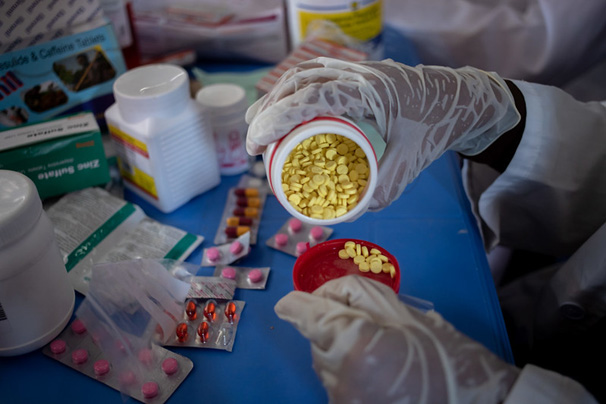 24 March 2024, Mogadishu, Somalia – WHO Somalia, in collaboration with the Federal Ministry of Health and Human Services, marks World Tuberculosis Day 2024 with a renewed commitment to end the tuberculosis (TB) epidemic. Under the theme “Yes! We can end TB!”, WHO aims to inspire hope and promote high-level leadership, increased investments, faster uptake of new WHO recommendations and innovations, and multisectoral collaboration to combat TB.
24 March 2024, Mogadishu, Somalia – WHO Somalia, in collaboration with the Federal Ministry of Health and Human Services, marks World Tuberculosis Day 2024 with a renewed commitment to end the tuberculosis (TB) epidemic. Under the theme “Yes! We can end TB!”, WHO aims to inspire hope and promote high-level leadership, increased investments, faster uptake of new WHO recommendations and innovations, and multisectoral collaboration to combat TB.
“Somalia’s TB programme has weathered recurring climatic shocks, insecurity and the COVID-19 pandemic to show an 87% treatment success rate, 14% decrease in TB incidence, and increase in TB treatment centres from a mere 7 to 109 in the past 2 decades,” said Mr Mohamed Jafar, National TB Programme Manager, Federal Ministry of Health and Human Services. “Even though we are making progress, we still need more support to sustain the gains made over the years, especially in the form of molecular testing machines and outreach activities, as both are critical for case detection.”
TB is a major public health problem in Somalia. Despite the country’s fragility, Somalia’s TB programme has made significant progress since it was re-established in 1995 following its collapse early in the civil war. TB incidence has reduced from 286 cases per 100 000 population in 2010 to 246 cases per 100 000 population in 2023 – a 14% decrease over 14 years.
The number of TB treatment centres in Somalia grew from just 7 centres in 1995 to 109 centres in 2023. TB cases enrolled on treatment have also gradually increased in number, from 10 469 cases per year in 2010 to 18 604 cases per year in 2023. Overall, during this period, the programme enrolled a total of 211 554 TB cases on treatment. The programme successfully saved the lives of 184 052 TB cases from 2010 to 2023 – giving an average treatment success rate of 87%.
WHO Somalia helped the Ministry of Health to establish Somalia’s first treatment centre for drug-resistant TB in 2013 and there are now 11 such centres, which together cover the whole country. Since 2015, a total of 2021 drug-resistant TB cases have been enrolled for treatment. Nearly 1456 of these cases were successfully treated (average treatment success rate of 72%).
Status of TB treatment in Somalia
Management of Somalia’s TB programme is based on WHO’s End TB Strategy, which involves adopting all its diagnostic and treatment regimens. The programme has deployed 100 molecular testing machines, 10 of which are coloured modules for rapid diagnosis of tuberculosis, including cases resistant to second-line TB drugs.
Introduction of this module is proving to be a game-changer in the diagnosis of drug-resistant TB in Somalia. Multidrug resistance can now be diagnosed in the country’s peripheral TB centres instead of solely at its TB culture laboratories. It has three TB culture laboratories capable of diagnosing TB drug resistance to second line TB drugs.
The TB programme is slowly but surely integrating into the country’s emerging primary health care system and private sector. Currently, nearly 50% of the TB centres are fully integrated with primary health care. Also, 7 private hospitals are implementing National TB programme policies to manage TB cases, including reporting quarterly to the TB programme.
Referral mechanisms are also in place to connect other private health providers to the National TB programme. In addition, community involvement in the programme is a key priority, not least because community health workers play an active role in identification and referral of potential TB cases. They also promote treatment adherence and advocacy in the community.
Dr Sindani Ireneaus Sebit, WHO’s focal person for Somalia’s TB programme, said: “As a major partner to the National TB programme, WHO continues to provide essential technical assistance to the Ministry of Health and plays a vital role in TB drug management to ensure that TB drugs are available to patients at their convenience, with no chance of stock-outs.” He added: “As we celebrate World TB Day, let us remember that with the effective coordination created in country among various partners and by exploring further resources, ‘Yes! We can end TB!’ in Somalia.”
For more information, please contact:
Fouzia Bano, Communications Officer, WHO Somalia
Email:
Saeed Ahmed, Reporting/External Relations Officer, WHO Somalia
Email:
ECHO funds help provide lifesaving health supplies and services to over 5 million population across drought-affected states in Somalia
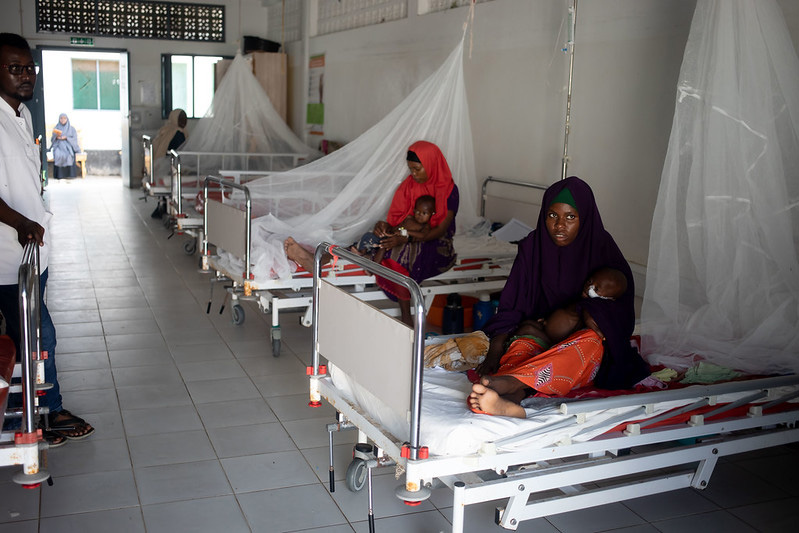 ECHO-funded project helped equip 11 nutrition stablisation centres across target districts with severe acute malnutrition kits to record a cumulative average cure rate of 94.25% amongst under five children. Photo Credit: WHOSom/I. Taxta18 March, 2024 - Mogadishu, Somalia - The United Nations Population Fund (UNFPA) and the World Health Organization (WHO), with funding from the European Civil Protection and Humanitarian Aid Operations (EU ECHO), have supported the Federal and State Ministries of Health to provide lifesaving health supplies and services to over 5 million people across drought-affected areas of Banadir, South West, Jubbaland and Galmudug states in Somalia.
ECHO-funded project helped equip 11 nutrition stablisation centres across target districts with severe acute malnutrition kits to record a cumulative average cure rate of 94.25% amongst under five children. Photo Credit: WHOSom/I. Taxta18 March, 2024 - Mogadishu, Somalia - The United Nations Population Fund (UNFPA) and the World Health Organization (WHO), with funding from the European Civil Protection and Humanitarian Aid Operations (EU ECHO), have supported the Federal and State Ministries of Health to provide lifesaving health supplies and services to over 5 million people across drought-affected areas of Banadir, South West, Jubbaland and Galmudug states in Somalia.
The 24-month ECHO-funded project is to increase access to life-saving health and nutrition services for populations within IDP camps and host communities and addressing the needs of pregnant and lactating women, elderly individuals, and children under five in drought and conflict-affected areas.
Both the WHO and UNFPA supported federal and state ministries of health, and partner organizations to provide life-saving preventative and care services through the procurement and distribution of essential medical supply for effective case management of severe acute malnutrition with medical complications in children, essential health and severe malnutrition kits (including reproductive health kits), as well as to support the timely detection and response to outbreaks. The beneficiaries of these health interventions included over 50% of women and over 1.2 million under-five years of age children in the drought-affected communities.
Simultaneously, the WHO and UNFPA partnership helped mitigate the impact of flash flooding resulting from El-Nino impact in Jubbaland and surrounding states by providing healthcare services to internally displaced populations towards the last quarters of 2023.
Mr. Niyi Ojuolape, UNFPA Somalia Country Representative, commented, 'We are committed to mitigating the impact of drought and conflict on vulnerable populations, particularly pregnant women and young children.'
Dr Renee Van de Weerdt, WHO Representative to Somalia, while appreciating the collaboration between WHO, UNICEF, UNFPA and the Ministry of Health said, 'The drought and food insecurity have severely impacted people health and the Somalian health system. WHO is committed to support the government of Somalia to make the health system more resilient and adapted to climate-related events .'
With support from ECHO, UNFPA, UNICEF and WHO and its health cluster partners will continue to support the government of Somalia with the procurement and distribution of medical supplies to manage severe acute malnutrition, provide emergency obstetric and neonatal care and other reproductive health services, and better detect and respond to outbreaks until April 2025.
For media inquiries, please contact:
UNFPA, Somalia: Fatimah Shah, Communications & Advocacy Specialist,
WHO, Somalia: Fouzia Bano, Communications Officer,
*Note to Editors:
ECHO is the Humanitarian Aid department of the European Commission that provides emergency assistance and relief to the victims of natural disasters or armed conflict outside the European Union.
UNFPA is the United Nations’ (UN) agency that promotes reproductive health, gender equality, and population development to improve the well-being of individuals and communities worldwide.
WHO is the UN’s specialized agency of the United Nations responsible for international public health and leading the health cluster in Somalia.
This project builds on ECHO’s previous support to WHO’s drought response entitled “Support to essential life-saving primary healthcare services and epidemic detection and response through the procurement and distribution of essential medical equipment, supplies and medicines to drought-affected districts in Somalia”.
Further information is available at
[1] https://www.emro.who.int/somalia/priority-areas/drought-response.html
International Women’s Day 2024: advancing gender equality in Somalia’s health workforce
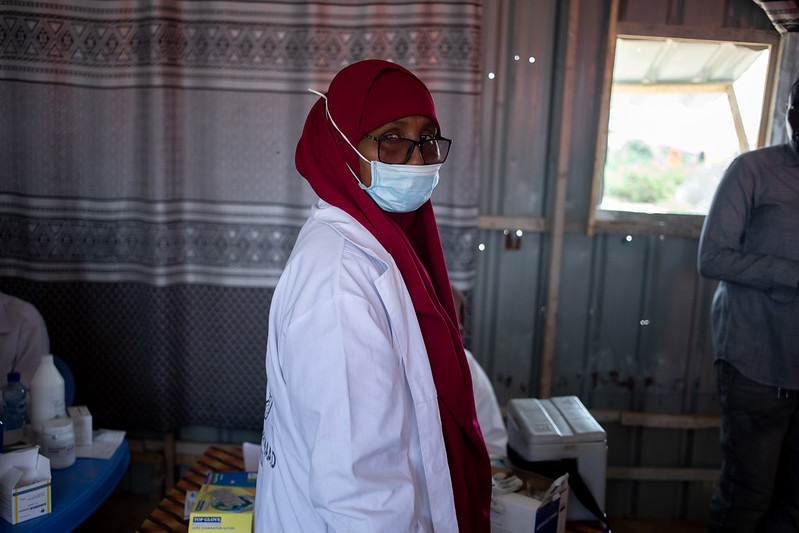 8 March 2024, Mogadishu, Somalia – Somalia’s health ministry and WHO observed International Women’s Day 2024 with a resolve to improve life for women in Somalia by empowering the female health workforce. To do so, they will address policy, human resource and operational matters, as well as capacity-building gaps for women in the health sector.
8 March 2024, Mogadishu, Somalia – Somalia’s health ministry and WHO observed International Women’s Day 2024 with a resolve to improve life for women in Somalia by empowering the female health workforce. To do so, they will address policy, human resource and operational matters, as well as capacity-building gaps for women in the health sector.
“Invest in women: Accelerate progress” is this year’s theme for the global day – and a timely reminder to world leaders to meet the targets of Sustainable Development Goal 3.
Dr Naima Abdulkadir, Manager of Reproductive Health at the Federal Ministry of Health and Human Services, thanked WHO for its support to various capacity-building efforts by the Ministry. She said she hoped: “WHO will continue to invest in trainings like mid-level management, integrated management of newborn and childhood illnesses, basic as well as emergency obstetric and newborn care, maternal and perinatal death surveillance and response and support for survivors of gender-based violence, because initial results of these trainings have been very encouraging and it will surely help in women’s empowerment in the health sector especially in newly liberated areas and in decision-making bodies.”
Life is harsh for many girls and women in the country. Somalia ranks fourth lowest among all countries globally for gender equality; its maternal and infant mortality rates are some of the highest in the world; and child marriage is widespread.
Women are often more affected than men by the recurring climatic shocks and ongoing conflicts that cause mass displacement across the country. More than 80% of the country’s 3.8 million internally displaced people are women and children. Many of them lack access to basic health services such as psychosocial support, reproductive health services, child and adolescent health services, and support for survivors of gender-based violence.
Somalia remains one of the most dangerous places to give birth. One in 1000 girls and women of reproductive age (15–49 years) die due to pregnancy or birth-related complications. Access to antenatal and postnatal care is still very limited: only 24% of women receive the WHO-recommended 4 or more antenatal care sessions during their pregnancy.
Despite recurring droughts, the COVID-19 pandemic and El Niño-related floods in Somalia, WHO and the Federal Ministry of Health and Human Services have made some progress in addressing women’s health issues under the wider umbrella of universal health coverage.
WHO Somalia supported the Ministry to revise (and cost the operational plan for) the National Reproductive, Maternal, Newborn, Child and Adolescent Health (RMNCAH) Strategy for 2023–2027. It also helped developing various guidelines for health worker capacity-building and for preparing women for health sector leadership roles.
The National Health Professionals Council, the regulatory framework for health professionals, is accelerating the process for registration of nurses and midwives, mostly women. In terms of patients’ right to health, the regulations and code of conduct are promoting the entitlement of women to decide about medical treatment, a critical step on a long way.
Dr Al-Umra Umar, Programme Lead for RMNCAH at WHO Somalia, welcomed the validation of the National RMNCAH Strategy, and added: “To tackle the high maternal and neonatal as well as under-five mortality, we urge the donor community to step up and help WHO streamline and reform the health sector by investing in an evidence-based and women-centred futuristic roadmap.”
“Slowly but gradually, we have managed to assemble an accountable and measurable framework to help address the predicaments of Somalia’s women, newborns and adolescents,” she said. “We will continue to build the capacities of women to help them take on decision-making and leadership roles.”
Media contacts
For more information, please contact:
Fouzia Bano, Communications Officer, WHO Somalia
Email:
Saeed Ahmed, Donor Reporting and External Relations Officer, WHO Somalia
Email:
Notes to editors
Somalia has some of the highest rates of neonatal and under-five mortality in the world, with an under-five mortality rate of 117 per 1000 live births. In addition, more than 1.5 million children aged under 5 years are currently at risk of severe malnutrition and related health complications due to the ongoing drought crisis. Somalia has a significant population of young people: over 45% of the population is aged under 15 years; about 75% of the population is aged under 30 years.
The latest Somali Health and Demographic Survey shows that female genital mutilation affects 99.2% of girls and women aged 15–49 years. This harmful practice has both short- and long-term physiological, sexual and psychological impacts. Gender-based violence is one of the most prevalent human rights violations faced by people, women especially, across the globe. Since the outbreak of COVID-19, women and girls have faced an even greater risk of such violence. Moreover, 35% of girls in Somalia go through child marriage, and there is no legal framework to stop it in courts.
Somalia’s gross domestic product per capita has consistently ranked among the 5 lowest in the world over the last decade; in 2020, it was the second lowest globally. In 2019, the International Labour Organization estimated labour force participation among those aged 15–64 years at 73.6% for men and just 23.1% for women. These figures have been relatively stable over the past 10 years. Agriculture still employs more men (79.2% of the labour force) and women (83.9%) than any other sector.
CERF support safeguards lives of 95.9% of children at WHO-Supported stabilization centres in Somalia
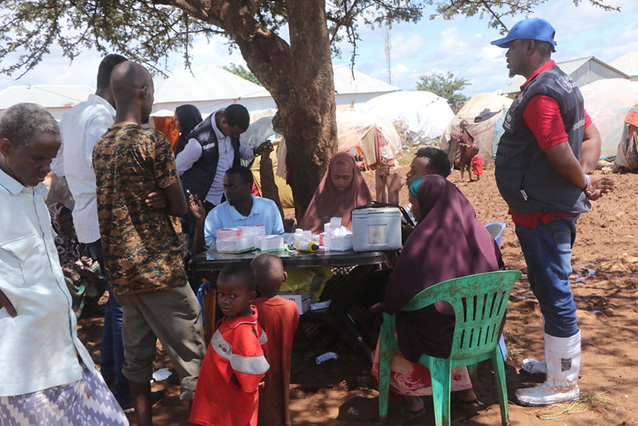 WHO–CERF support helped Somalia’s Federal Ministry of Health to set up outreach camps for flood-affected communities across Jubaland and Hirshabelle states. Photo credit: WHO Somalia/A. Mustaf08 February 2024, Mogadishu, Somalia – The WHO Country Office in Somalia, with timely support from the Central Emergency Response Fund (CERF), has helped to avert major diseases outbreaks after flash flooding caused by El Niño. The floods, which hit the country in November 2023, damaged infrastructure and affected the livelihoods and health of over 1.17 million people across Jubaland and Hirshabelle states.
WHO–CERF support helped Somalia’s Federal Ministry of Health to set up outreach camps for flood-affected communities across Jubaland and Hirshabelle states. Photo credit: WHO Somalia/A. Mustaf08 February 2024, Mogadishu, Somalia – The WHO Country Office in Somalia, with timely support from the Central Emergency Response Fund (CERF), has helped to avert major diseases outbreaks after flash flooding caused by El Niño. The floods, which hit the country in November 2023, damaged infrastructure and affected the livelihoods and health of over 1.17 million people across Jubaland and Hirshabelle states.
“The floods have swept away everything we had, but thanks to WHO, my 2 children have survived not only droughts and floods but are now recovering from severe malnutrition at the Kismayo General Hospital,” said the worried but satisfied Rasuliyan, mother of Haniya (aged 3 years) and Uthman (aged 4 years) while visiting one of 64 WHO-supported stabilization centres in the country.
To mitigate the impact of El Niño and the Indian Ocean Dipole, WHO Somalia – with the support from CERF – supported the federal and state ministries of health to boost their efforts to meet the growing needs of over 500 000 displaced people. It did so by deploying over 25 outreach teams – comprising 100 health workers in total: nurses, clinicians, social workers and nutrition screeners – and 130 community health workers (CHWs).
By the end of January 2024, the outreach teams had managed to reach 163 880 people, including 4148 pregnant women, in the most affected districts across the 2 states. They held 93 416 outpatient consultations, administered 23 145 vaccinations and referred 5418 people with severe medical ailments to more specialized care.
The WHO–CERF initiative has helped to equip and staff the stabilization centres at Kismayo General Hospital, Baardheere District Hospital, Beledweyne Hospital and Jowhar Hospital to support the management of cases of acute malnutrition with complications. These cases may be referred by the CHWs and the outreach teams or may be admitted via another entry point.
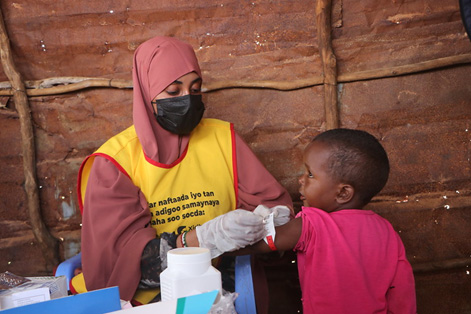 Outreach teams screened 33 767 children aged under 5 years, identifying 4833 children with severe acute malnutrition who were referred to outpatient therapeutic and stabilization centres. Photo credit: WHO Somalia/A. Mustaf“Of all the admissions in these stabilization centres, 95.9% were cured,” said WHO’s Incident Manager Dr Ifeanyi Okudo. He added that CHWs remain crucial as they administer micronutrient supplements within the displaced communities. By the end of January, they had reached 4148 pregnant women with iron and folic acid to prevent anaemia and birth defects. They also provided 4088 children with vitamin A supplements to boost immunity to diseases such as measles and pneumonia and to prevent blindness, which is common in malnourished children.
Outreach teams screened 33 767 children aged under 5 years, identifying 4833 children with severe acute malnutrition who were referred to outpatient therapeutic and stabilization centres. Photo credit: WHO Somalia/A. Mustaf“Of all the admissions in these stabilization centres, 95.9% were cured,” said WHO’s Incident Manager Dr Ifeanyi Okudo. He added that CHWs remain crucial as they administer micronutrient supplements within the displaced communities. By the end of January, they had reached 4148 pregnant women with iron and folic acid to prevent anaemia and birth defects. They also provided 4088 children with vitamin A supplements to boost immunity to diseases such as measles and pneumonia and to prevent blindness, which is common in malnourished children.
The 130 CHWs deployed in the affected communities also helped screen 33 767 children aged under 5 years for malnutrition using mid-upper arm circumference tape. This effort identified 4833 children with severe acute malnutrition, who were referred to outpatient therapeutic and stabilization centres for care.
The CERF support also helped WHO to procure 22 paediatric kits for children with severe acute malnutrition. These have been provided to the stabilization centres in the Kismayo General, Baardheere District, Beledweyne and Jowhar hospitals. The kits will be used to manage cases of acute malnutrition with complications referred to the centres by the CHWs and the outreach teams.
For more information, please contact:
Fouzia Bano, Communications Officer, WHO Somalia
Email:
Saeed Ahmed, Reporting/External Relations Officer, WHO Somalia
Email:
Related links


